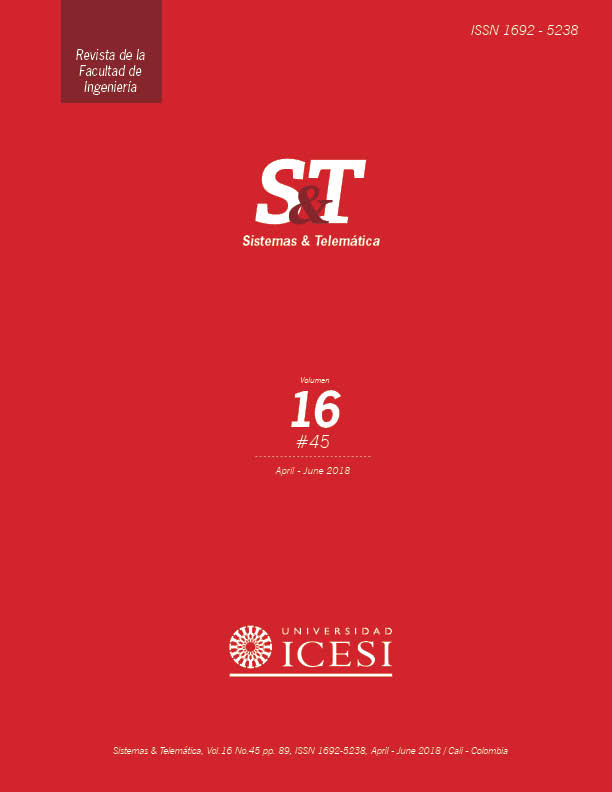Towards smarter cities taking advantage of the Fog Computing paradigm
DOI:
https://doi.org/10.18046/syt.v16i45.2756Keywords:
Fog computing; cloud computing; smartcities.Abstract
The fog computing term has achieved importance in the last years due to its effect in the latency reduction that the Internet of Things [IoT] applications have. These applications demand real-time (or nearly real-time) responses and they are characterized by low bandwidth consumption; hence, the fog computing is relevant in achieving these requests because part of the processing is done near the end user devices. For this reason, the cloud computing paradigm is not enough for some applications, since nowadays, the instant need of data and the decision-making process leverage –or somehow discover– a new horizon that demands a complementary variable. This article consists on an approach to the fog computing term, together with the requirements analysis for engineering solutions in the IoT field. Also, its impact in the smart cities and other fields plus its main challenges are addressed. We also present a guideline to implement a recommendation system for sightseeing places for tourists based in fog computing embraced in a large smart city project located in Havana.
References
Akamai Technologies. (2017). Q1 2017 State of the Internet / Connectivity Report. Retrieved from: https://www.akamai.com/us/en/multimedia/documents/state-of-the-internet/q1-2017-state-of-the-internet-connectivity-report.pdf
Arco Research Group (2017, March 12). El papel de la tecnología de lógica reconfigurable como respuesta a los retos del Internet de las Cosas. Retrieved from: https://arcoresearchgroup.wordpress.com/2017/03/12/el-papel-de-la-tecnologia-de-logica-reconfigurable-como-respuesta-a-los-retos-del-internet-de-las-cosas/
Bojanova, I. (2015). What makes up the Internet of Things? Retrieved from: https://www.computer.org/web/sensing-iot/content?g=53926943&type=article&urlTitle=what-are-the-components-of-iot-
Bonomi,F., Milito, R., Zhu, J., & Addepalli, S. (2012). Fog computing and its role in the Internet of Things. In: Proceedings of the first edition of the MCC Workshop on Mobile Cloud Computing, (pp. 13-16). New York, NY: ACM.
Cardellini, V., Grassi, V., Lo Presti, F., Nardelli, M. (2015). On QoS-aware Scheduling of Data Stream Applications over Fog Computing Infrastructures. In: 2015 IEEE Symposium on Computers and Communication (ISCC), (pp. 271-276). doi:10.1109/ISCC.2015.7405527
Cisco Systems. (2017). Fog computing and the Internet of things: Extend the cloud to where the things are [white paper]. Retrieved from: https://www.cisco.com/c/dam/en_us/solutions/trends/iot/docs/computing-overview.pdf
De Fuenmayor, A. (2017, Feb. 20). Cloud computing, ¿el final de una era? [blog ThinkingBig]. Retrieved from: https://aunclicdelastic.blogthinkbig.com/cloud-computing-iot/
Gonzalez, G., Delgado, T., Capote, J. L., & Cruz, R. (2013). Context-aware recommender system based on ontologies. In: H. Onsrud, & A. Rajabifard (Eds.), Spatially enablement in support of economic development and poverty reduction, (pp. 227-243). Reston, VA: GSDI.
Gupta, H., Vahid-Dastjerdi, A., Ghosh, S.K., Buyya, R. (2017). FogSim: A toolkit for modeling and simulation of resource management techniques in internet of things, edge and fog computing environments. Software: Practice and Experience, 47(9), 1275-1296.
Hu, P., Dhelim, S., Ning, H. Qiu, T. (2017). Survey on fog computing: Architecture, key technologies, applications and open issues. Journal of Network and Computer Applications, 98, 27-42.
International Telecommunications Union [ITU]. (25/ 4/2017). The Manizales Manifesto. Retrieved from: https://www.itu.int/en/ITU-T/Workshops-and-Seminars/gsw/201704/Documents/Manifesto-Manizales-05-04-2017-Eng-Final.pdf
Lai, C. F., Song, D. Y., Hwang, R. H., & Lai, Y. X. (2016). A QoS-aware streaming service over fog computing infrastructures. In Digital Media Industry & Academic Forum (DMIAF), (pp. 94-98). IEEE.
Mapped: The world according to Internet connection speeds - Telegraph (2017, April, 9). Retrieved from: http://www.telegraph.co.uk/travel/maps-and-graphics/countries-with-fastest-internet-connection-speeds/
Mohamed, N., Al-Jaroodi, J., Jawhar, I., Lazarova-Molnar, S., & Mahmoud, S. (2017). Smartcityware: A service-oriented middleware for cloud and fog enabled smart city services. IEEE Acces, 5, 17576-17588. doi:r 10.1109/ACCESS.2017.2731382
Varshney, P., & Simmhan, Y. (2017). Demystifying fog computing: Characterizing architectures, applications and abstractions. In Fog and Edge Computing (ICFEC), 2017 IEEE 1st International Conference on (pp. 115-124). IEEE.
Yousefpour, A., Ishigaki, G., & Jue, J. P. (2017). Fog computing: Towards minimizing delay in the internet of things. In Edge Computing (EDGE), 2017 IEEE International Conference on (pp. 17-24). IEEE.
Downloads
Published
Issue
Section
License
This journal is licensed under the terms of the CC BY 4.0 licence (https://creativecommons.org/licenses/by/4.0/legalcode).



